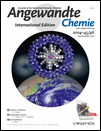An Iridium Difluoroketene Complex: Synthesis and Isolation†
Supported by the U.S. National Science Foundation through grant no. CHE-0094349. Funding for the AV-500 spectrometer was made available through grants from the NSF (CHE 0130862) and NIH (S10 RR 016634). We gratefully thank Ms. Cathleen M. Yung for assistance with low-temperature NMR experiments and Drs. Fred Hollander and Alan Oliver for X-ray analysis of compound 5.
Graphical Abstract
Deprotonation of the trifluoroacyl hydride complex 1 with tert-butyllithium leads to difluoroketene adduct 2. Coordination of the difluoroketene to iridium through the CC bond is confirmed by X-ray diffraction (see scheme). This complex is the first isolated and characterized dihaloketene complex and provides the only structural data for difluoroketene.





